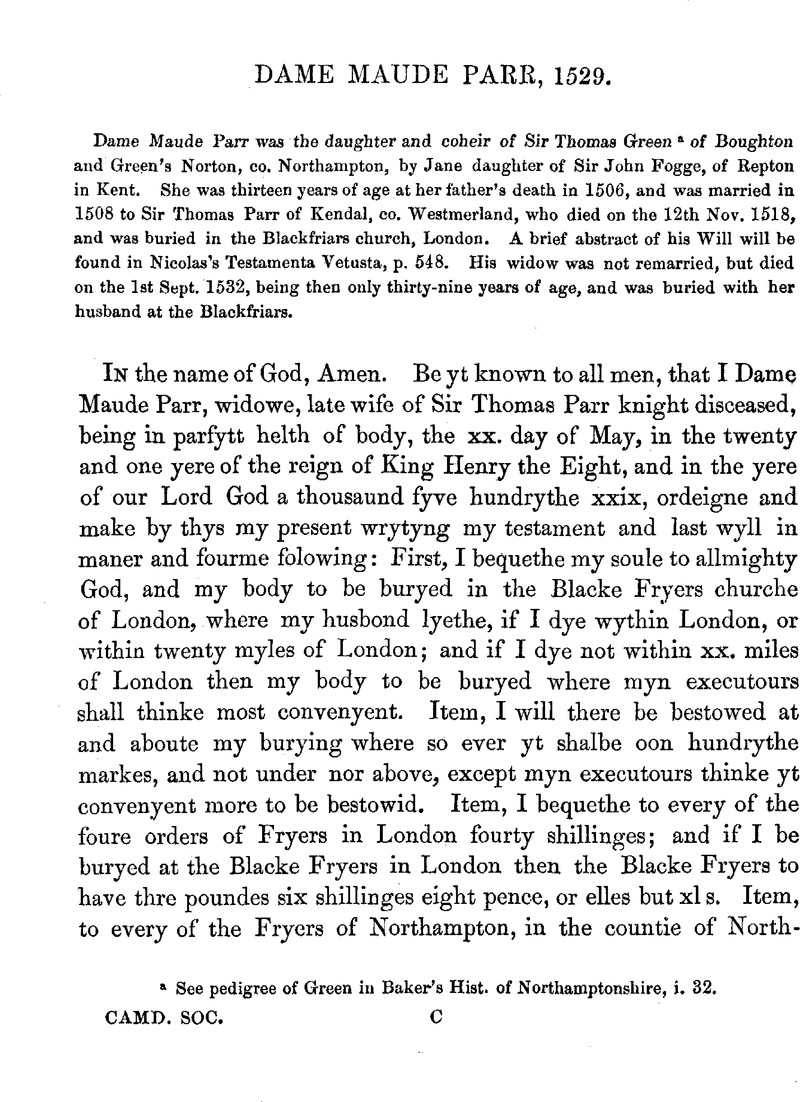No CrossRef data available.
Article contents
Dame Maude Parr, 1529
Published online by Cambridge University Press: 23 February 2010
Abstract

- Type
- Wills from Doctors' Commons
- Information
- Copyright
- Copyright © Royal Historical Society 1863
References
page 9 note a See pedigree of Green in Baker's Hist, of Northamptonshire, i. 32.
page 10 note a Afterwards Lord Parr of Kendal 1538, Earl of Essex 1543, Marquess of Northampton 1546–7, K.G. and Lord Great Chamberlain; died 1570. His marriage with the lady Anne Bourchier, daughter and heiress of Henry Earl of Essex and Ewe, mentioned in the present document, afterwards took place, but proved unfortunate, for her issue were bastardized by act of parliament 1543, and finally the marriage was annulled by act of parliament 1551. She died Jan. 26, 1570–1.
page 10 note b Katharine Parr, who became in 1543 the sixth and last wife of King Henry the Eighth, was first married to Edward Borough, son and heir apparent of Thomas Lord Borough of Gainsborough.
page 11 note a Anne Parr became the first wife of Sir William Herbert, created Earl of Pembroke in 1551. She appears in history as Lady Herbert during the queendom of her sister Katharine. She died at Baynard's Castle in London on the 28th Feb. 1551–2, and was buried in St. Paul's cathedral. See her funeral in Machyn's Diary, p. 15, and the engraving of her monument in Dugdale's History of St. Paul's.
page 12 note a Sir William Parr, of Horton, co. Northampton, lord chamberlain to his niece Queen. Katharine, and summoned to parliament Dec. 23, 1543. He died Sept. 10, 1546.
page 12 note b Denny in Cambridgeshire, of nuns of the order of St. Clare.
page 13 note a Sir William FitzWilliam, the first of Milton in Northamptonshire (by purchase) and direct ancestor of the present Earl FitzWilliam, was a grandson of the marriage of Sir John FitzWilliam of Sprotborotigh, co. York, with Eleanor, daughter of Sir Henry Green, of Drayton, co. Northampton; which Sir Henry was a younger brother of Sir Thomas Green of Green's Norton; and thus Sir William FitzWilliam was a remote cousin of the testator. See the pedigree of FitzWilliam in Hunter's South Yorkshire, vol. ii. p. 93, and that of Green of Drayton in Bridges's History of Northamptonshire, vol. ii. p. 251; but as there are only five generations on Sir William's side, and seven are given on that of Dame Maude Parr, there is some reason to suspect that Mr. Baker, in his pedigree of Green (Hist, of Northamptonshire, i. 32), has made too many generations in the six successive Sir Thomas Greens of Boughton and Norton, of whom the first is stated to have died in 1391 and the last in 1506. (He is mentioned again twice in p. 15.)
page 13 note b There can be little doubt that this is an early notice of the future chief justice, the founder of the great house of Montague, which has subsequently attained so many high dignities of the peerage. He was the second son of Thomas Montague of Hemington in Northamptonshire, who died in 1517; and he was not yet a serjeant-at-law when this will was written, though he had officiated as autumn reader at the Middle Temple in 1524: see Foss's Lives of the Judges, vol. v. p. 309.
page 14 note a How Thomas Pickering was the testators cousin does not readily appear. The Pickerings of Tichmersh in Northamptonshire, afterwards Baronets of Nova Scotia, were descended from a younger son of an ancient Westmorland family; but the name of Thomas (at this period) does not occur in the account given of them in Bridges's History of Northamptonshire, vol. ii. p. 383.




